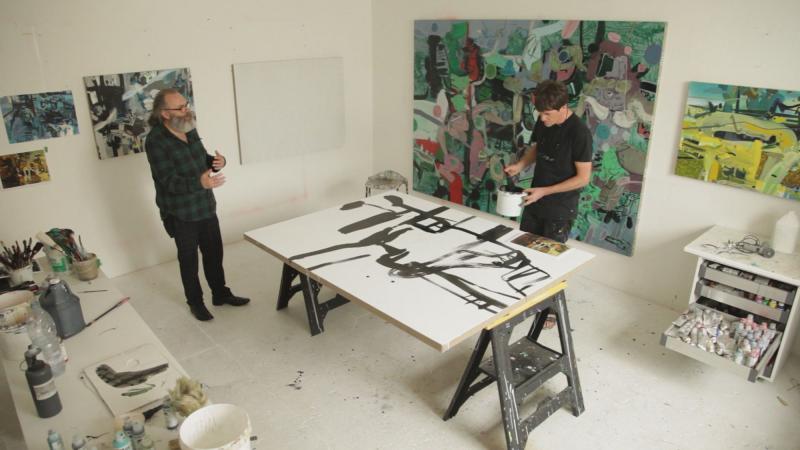The Rules of Abstraction with Matthew Collings, BBC Four | reviews, news & interviews
The Rules of Abstraction with Matthew Collings, BBC Four
The Rules of Abstraction with Matthew Collings, BBC Four
Revelation of early Swedish woman artist opened magpie survey of abstract art

Artist and critic Matthew Collings purported to set out the rules of abstraction through taking the viewer on a very bumpy ride through 20th century painting, with a nod to Cézanne to get us started.
The classic dating for abstraction in most chronologies clusters round the Russians – Kandinsky, Malevich and the Paris-based Sonia Delaunay a few years later, all of whom featured prominently; the phenomenon was notably associated, as Collings pointed out, with Kandinsky’s affinity for music, and his publication “On the Spiritual in Art”. Abstraction meant, Collings suggested, that a sense of reality was up for grabs. And the results in the visual arts are all about shapes and spaces, a visual rhythm and composition: more affinity with music. The artist was to seek inspiration from the imagination, and his internal world, rather than responding to that perceived in the world around him.
Klint’s paintings were not true abstract art, instead the artist saw them as diagrams
But Klint was a disciple of the formidable Russian Madame Blavatsky, who was one of the founders of theosophy, espoused later by Mondrian among many others; seeking the spiritual beyond the perceived world, it aspired in an evolutionary progress towards an enlightenment that sought the spiritual in science and a scientific understanding of the spiritual. Thus, Klint’s paintings were not true abstract art, instead the artist saw them as diagrams. She left 23,000 pages of notes dictated to her by sources she referred to as the “High Masters”, and had a taste for séances. And the legacy of theosophy as we know it today is not in art, in spite of Mondrian and Kandinsky, but in the educational and meditative practices of Rudolf Steiner.
We got to watch Collings himself in his studio where he paints the ideas of his partner Emma Biggs in terms of colour and pattern – wholly abstract (Collings and Biggs, pictured below right). There was a very helpful visit to the outstanding abstract painter Fiona Rae, where we viewed her grappling with the notion of giving up colour to work with black and white, and watch her making the attempt; her common sense remarks did in fact cast light on abstraction by simply making the clear-cut suggestion that it is painting something that doesn’t really exist.
 But there was a fatal unevenness in the choice of artists. We had three charming interviews with abstract painters in Britain: the 92-year-old Bert Irvin, the black-garbed Dan Perfect, making as he said an introvert experience out of an extravert world, and Paul Tonkin who threw gallons of paint onto what seemed to be an elevated sheet, all of whom appeared to be incredibly hard working and dedicated, and producing delightful, decorative and derivative work.
But there was a fatal unevenness in the choice of artists. We had three charming interviews with abstract painters in Britain: the 92-year-old Bert Irvin, the black-garbed Dan Perfect, making as he said an introvert experience out of an extravert world, and Paul Tonkin who threw gallons of paint onto what seemed to be an elevated sheet, all of whom appeared to be incredibly hard working and dedicated, and producing delightful, decorative and derivative work.
To throw this relative shallowness into unfortunate focus, we were given an excursion into the mystical beauties of Mark Rothko (illustrating Collings’ fourth Rule, “Make the Surface Breathe”). Just before the conclusion, and with no explanation, we departed Europe and the US and visited the hubbub of the industrial studio space filled with young workers making patterns out of the salvaged metal foil bottle top wrappers in an heroic recycling operation masterminded by the Ghanaian artist El Anatsui. These have been called “bottle top installations” and marvels as they are, it was unclear why they hove into view in a programme that had hitherto concentrated on painting. Sculpture was omitted altogether.
This was the first in the BBC’s “When Art Broke Free” series devoted to abstraction in the arts, which promises (in its blurb, at least) to reveal how it rose to be “all around us in modern culture” (is it?) and that it is, and I quote, “the key artistic story of the 20th century”, knocking all those other -isms, from expressionism to surrealism, well out of the ring. As a piece of special pleading, The Rules of Abstraction didn’t quite convince: a lot more could have been done in 90 minutes than was done here. The effective electronic score wasn’t credited to any composer, but in this curiously empty film, much of the music made more of the points about abstraction than the hectic visuals did.
rating
Explore topics
Share this article
The future of Arts Journalism
You can stop theartsdesk.com closing!
We urgently need financing to survive. Our fundraising drive has thus far raised £33,000 but we need to reach £100,000 or we will be forced to close. Please contribute here: https://gofund.me/c3f6033d
And if you can forward this information to anyone who might assist, we’d be grateful.

Subscribe to theartsdesk.com
Thank you for continuing to read our work on theartsdesk.com. For unlimited access to every article in its entirety, including our archive of more than 15,000 pieces, we're asking for £5 per month or £40 per year. We feel it's a very good deal, and hope you do too.
To take a subscription now simply click here.
And if you're looking for that extra gift for a friend or family member, why not treat them to a theartsdesk.com gift subscription?

Add comment